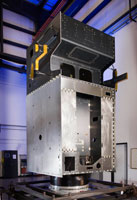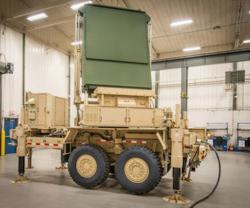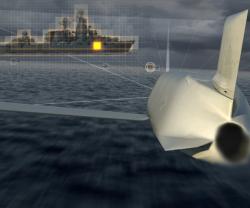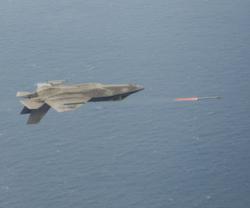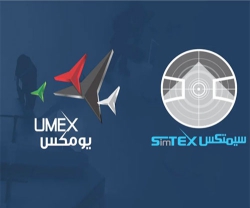Lockheed Delivers Core Structure for 4th SBIRS Satellite
25.05.2012 North America
Lockheed Martin has received the core structure for the U.S. Air Force’s fourth Space Based Infrared System (SBIRS) geosynchronous satellite (GEO-4).
The structure was delivered to Lockheed Martin's Mississippi Space & Technology Center, where engineers and technicians will integrate the spacecraft’s propulsion subsystem.
Featuring a mix of GEO satellites, hosted payloads in highly elliptical earth orbit, and associated ground hardware and software, SBIRS delivers resilient and improved missile warning capabilities for the nation while simultaneously providing significant contributions to the military's missile defense, technical intelligence and battlespace awareness mission areas.
The GEO-4 structure, identical to the previous three SBIRS GEO spacecraft, is made from lightweight, high-strength composite materials designed to withstand the accelerations and vibrations generated during launch and support the spacecraft throughout on-orbit operations.
“Delivery of the SBIRS GEO-4 core structure is a major milestone indicating the program is continuing to meet its commitments. Based on lessons learned from the first two SBIRS geosynchronous satellites, production of GEO-3 and GEO-4 is proceeding very well. In addition, we have a number of affordability initiatives in place jointly with the Air Force to continually reduce the cost of each follow-on SBIRS satellite,” said Louie Lombardo, Director of Lockheed Martin’s SBIRS Follow-on Production (SFP) program.
Lockheed Martin engineers and technicians will now integrate the propulsion subsystem with the core structure, which is essential for maneuvering the satellite during transfer orbit to its final location, as well as conducting on-orbit repositioning maneuvers throughout its mission life.
The integrated core propulsion module will then be shipped to Sunnyvale, California, for final assembly, integration and test. SBIRS GEO-4 is on schedule to be available for launch in 2015.
Lockheed Martin’s SBIRS contracts include four highly elliptical orbiting (HEO) payloads, four GEO satellites, and ground assets to receive, process, and disseminate the infrared mission data. The team expects to receive funding to begin long lead parts procurement for the fifth and sixth GEO satellite by the end of the year.
Additionally, under the Air Force’s Overhead Persistent Infrared (OPIR) Space Modernization Initiative (SMI), Lockheed Martin will evolve technologies to improve capability and affordability for future SBIRS spacecraft.
The SBIRS team is led by the Infrared Space Systems Directorate at the U.S. Air Force Space and Missile Systems Center.
Lockheed Martin is the SBIRS prime contractor, Northrop Grumman is the payload integrator. Air Force Space Command operates the SBIRS system.
The structure was delivered to Lockheed Martin's Mississippi Space & Technology Center, where engineers and technicians will integrate the spacecraft’s propulsion subsystem.
Featuring a mix of GEO satellites, hosted payloads in highly elliptical earth orbit, and associated ground hardware and software, SBIRS delivers resilient and improved missile warning capabilities for the nation while simultaneously providing significant contributions to the military's missile defense, technical intelligence and battlespace awareness mission areas.
The GEO-4 structure, identical to the previous three SBIRS GEO spacecraft, is made from lightweight, high-strength composite materials designed to withstand the accelerations and vibrations generated during launch and support the spacecraft throughout on-orbit operations.
“Delivery of the SBIRS GEO-4 core structure is a major milestone indicating the program is continuing to meet its commitments. Based on lessons learned from the first two SBIRS geosynchronous satellites, production of GEO-3 and GEO-4 is proceeding very well. In addition, we have a number of affordability initiatives in place jointly with the Air Force to continually reduce the cost of each follow-on SBIRS satellite,” said Louie Lombardo, Director of Lockheed Martin’s SBIRS Follow-on Production (SFP) program.
Lockheed Martin engineers and technicians will now integrate the propulsion subsystem with the core structure, which is essential for maneuvering the satellite during transfer orbit to its final location, as well as conducting on-orbit repositioning maneuvers throughout its mission life.
The integrated core propulsion module will then be shipped to Sunnyvale, California, for final assembly, integration and test. SBIRS GEO-4 is on schedule to be available for launch in 2015.
Lockheed Martin’s SBIRS contracts include four highly elliptical orbiting (HEO) payloads, four GEO satellites, and ground assets to receive, process, and disseminate the infrared mission data. The team expects to receive funding to begin long lead parts procurement for the fifth and sixth GEO satellite by the end of the year.
Additionally, under the Air Force’s Overhead Persistent Infrared (OPIR) Space Modernization Initiative (SMI), Lockheed Martin will evolve technologies to improve capability and affordability for future SBIRS spacecraft.
The SBIRS team is led by the Infrared Space Systems Directorate at the U.S. Air Force Space and Missile Systems Center.
Lockheed Martin is the SBIRS prime contractor, Northrop Grumman is the payload integrator. Air Force Space Command operates the SBIRS system.
Previous PostBoeing Wins US-NATO AWACS EMD Contract
Latest news
Latest events
Doha International Maritime Defence Exhibition & Conference (DIMDEX 2026)
19 - 22 Jan 2026Doha - QatarUMEX – SimTEX
20 - 22 Jan 2026ADNEC Centre Abu Dhabi, - United Arab EmiratesWorld Defense Show (WDS) 2026
08 - 12 Feb 2026Riyadh - Saudi ArabiaSAHA EXPO International Defence & Aerospace Exhibition
05 - 09 May 2026İstanbul Expo Center - Turkey

